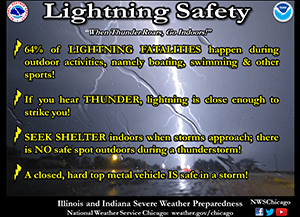Be Safe in Severe Summer Weather
Summer is the peak season for lightning strikes in North America, but a little caution and common sense can help you stay safe year-round. While lightning doesn’t have an off-season, the National Weather Service focuses its safety efforts in summer because that’s when problems tend to surge. Warm weather not only helps spawn thunderstorms, but it also draws people outside — setting the stage for a seasonal spike in lightning-related injuries and deaths.
If you have storm damage at your property, click here for more information on how BluSky can help you, if needed.
7 Tips to Stay Safe in Severe Summer Weather
For advice on how to stay safe this summer, and all year long, below are seven useful tips in honor of Lightning Safety Awareness Week.
1. Be on the lookout.
The simplest step in lightning safety is to avoid thunderstorms in the first place. Storms can pop up suddenly during summer, so it’s a good idea to check weather forecasts often before going out (as well as while you’re out, via a smartphone, radio or other portable device). Be especially wary of hitting the water in boats or jet skis when bad weather is brewing, since a storm might explode before you can get back to land. If you don’t have access to weather reports, keep an eye on the horizon for any tall, dark storm clouds with an anvil or cauliflower shape.
2. Take charge of the situation.
Lightning is just a huge spark of electricity, caused by opposite electrical charges within a storm or between clouds and the ground. There are two types of cloud-to-ground lightning: negative flashes that link a storm’s negatively charged interior to positively charged ground below, and positive flashes that connect a storm’s positive top to negative ground farther away. The latter type can strike about 10 miles outward from a storm, which is why it’s unwise to delay your retreat until you actually see clouds or feel rain — by then, it could already be too late.
3. Don’t ignore a fair warning.
 Thunder is the noise lightning makes as it rips through air, causing it to rapidly heat up and expand. Human ears can typically hear thunder up to 10 miles away from a lightning bolt, and since that’s also how far lightning can reach from its parent storm, this familiar sound really is as scary as your dog thinks it is. If you hear thunder while you’re outdoors, you’re already in danger. You should quickly head for a safe shelter, ideally without any metal objects like umbrellas or golf clubs that could make you an enticing target.
Thunder is the noise lightning makes as it rips through air, causing it to rapidly heat up and expand. Human ears can typically hear thunder up to 10 miles away from a lightning bolt, and since that’s also how far lightning can reach from its parent storm, this familiar sound really is as scary as your dog thinks it is. If you hear thunder while you’re outdoors, you’re already in danger. You should quickly head for a safe shelter, ideally without any metal objects like umbrellas or golf clubs that could make you an enticing target.
4. Be closed-minded.
Seek shelter ASAP when caught in a thunderstorm, but also keep in mind that not all shelter is the same. Trees are a terrible option, for example, since their height makes them more likely to be struck by lightning. The NWS suggests either a “substantial building” — i.e., one that’s fully enclosed with a roof, walls and floor, and has plumbing or wiring — or an enclosed metal vehicle. Avoid unsafe buildings such as carports, open garages, covered patios, picnic shelters, beach pavilions, golf shelters, tents, baseball dugouts, sheds and greenhouses. Unsafe vehicles include golf carts, convertibles, motorcycles and any others with open cabs.
5. Keep a low profile.
Finding a safe enclosed shelter is the best way to escape lightning, but there are also ways to slightly reduce the risks if you can’t reach a building or a car. The first is to get away from tall trees, flagpoles, power lines or other vertical structures, especially if they contain metal. The second is to avoid becoming a lightning rod yourself: Crouch low to the ground, but don’t kneel, sit or lie down. The idea is to touch the ground as little as possible, so try not to even put your hands on it. And, if possible, keep looking for a suitable shelter.
6. Don’t forget the pets.
Your dog may already have a healthy fear of thunder, but since he probably doesn’t quite understand why, he still needs your help to stay safe. Don’t leave dogs or other pets outside if a thunderstorm is expected, and don’t let them seek refuge in a doghouse, open barn or other vulnerable structure.
7. Think outside the box.
You’re much safer from lightning in an enclosed building, but you’re not totally safe. There are several ways lightning can sneak inside, such as phone lines, electrical wires, water pipes, doors and windows. Use cordless phones or cellphones if you must talk mid-storm, and wait until after the storm passes to take a shower or bath. You can protect TVs, computers and other electronics by unplugging them in advance, but it’s risky to do so during a storm since you could be shocked in the process. And while it may be tempting to watch a storm from your porch or balcony, that would mean you’re back outside — and back in danger.
Again, if you experience storm damage to your home or property, call us at 303.789.4258.
Thank you to Mother Nature Network.


